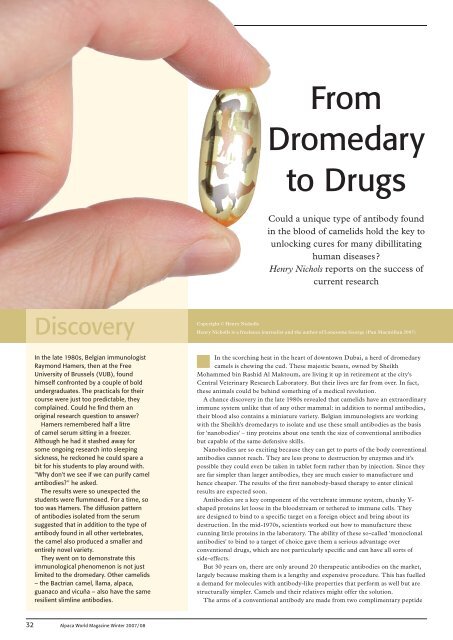Winter - Classical MileEnd Alpacas
Winter - Classical MileEnd Alpacas
Winter - Classical MileEnd Alpacas
Create successful ePaper yourself
Turn your PDF publications into a flip-book with our unique Google optimized e-Paper software.
From<br />
Dromedary<br />
to Drugs<br />
Could a unique type of antibody found<br />
in the blood of camelids hold the key to<br />
unlocking cures for many dibillitating<br />
human diseases ?<br />
Henry Nichols reports on the success of<br />
current research<br />
Discovery<br />
In the late 1980s, Belgian immunologist<br />
Raymond Hamers, then at the Free<br />
University of Brussels (VUB), found<br />
himself confronted by a couple of bold<br />
undergraduates. The practicals for their<br />
course were just too predictable, they<br />
complained. Could he find them an<br />
original research question to answer?<br />
Hamers remembered half a litre<br />
of camel serum sitting in a freezer.<br />
Although he had it stashed away for<br />
some ongoing research into sleeping<br />
sickness, he reckoned he could spare a<br />
bit for his students to play around with.<br />
"Why don't we see if we can purify camel<br />
antibodies?" he asked.<br />
The results were so unexpected the<br />
students were flummoxed. For a time, so<br />
too was Hamers. The diffusion pattern<br />
of antibodies isolated from the serum<br />
suggested that in addition to the type of<br />
antibody found in all other vertebrates,<br />
the camel also produced a smaller and<br />
entirely novel variety.<br />
They went on to demonstrate this<br />
immunological phenomenon is not just<br />
limited to the dromedary. Other camelids<br />
– the Bactrian camel, llama, alpaca,<br />
guanaco and vicuña – also have the same<br />
resilient slimline antibodies.<br />
In the scorching heat in the heart of downtown Dubai, a herd of dromedary<br />
camels is chewing the cud. These majestic beasts, owned by Sheikh<br />
Mohammed bin Rashid Al Maktoum, are living it up in retirement at the city's<br />
Central Veterinary Research Laboratory. But their lives are far from over. In fact,<br />
these animals could be behind something of a medical revolution.<br />
A chance discovery in the late 1980s revealed that camelids have an extraordinary<br />
immune system unlike that of any other mammal: in addition to normal antibodies,<br />
their blood also contains a miniature variety. Belgian immunologists are working<br />
with the Sheikh's dromedarys to isolate and use these small antibodies as the basis<br />
for 'nanobodies' – tiny proteins about one tenth the size of conventional antibodies<br />
but capable of the same defensive skills.<br />
Nanobodies are so exciting because they can get to parts of the body conventional<br />
antibodies cannot reach. They are less prone to destruction by enzymes and it's<br />
possible they could even be taken in tablet form rather than by injection. Since they<br />
are far simpler than larger antibodies, they are much easier to manufacture and<br />
hence cheaper. The results of the first nanobody-based therapy to enter clinical<br />
results are expected soon.<br />
Antibodies are a key component of the vertebrate immune system, chunky Y-<br />
shaped proteins let loose in the bloodstream or tethered to immune cells. They<br />
are designed to bind to a specific target on a foreign object and bring about its<br />
destruction. In the mid-1970s, scientists worked out how to manufacture these<br />
cunning little proteins in the laboratory. The ability of these so-called 'monoclonal<br />
antibodies' to bind to a target of choice gave them a serious advantage over<br />
conventional drugs, which are not particularly specific and can have all sorts of<br />
side-effects.<br />
But 30 years on, there are only around 20 therapeutic antibodies on the market,<br />
largely because making them is a lengthy and expensive procedure. This has fuelled<br />
a demand for molecules with antibody-like properties that perform as well but are<br />
structurally simpler. Camels and their relatives might offer the solution.<br />
The arms of a conventional antibody are made from two complimentary peptide<br />
32 Alpaca World Magazine <strong>Winter</strong> 2007 / 08







